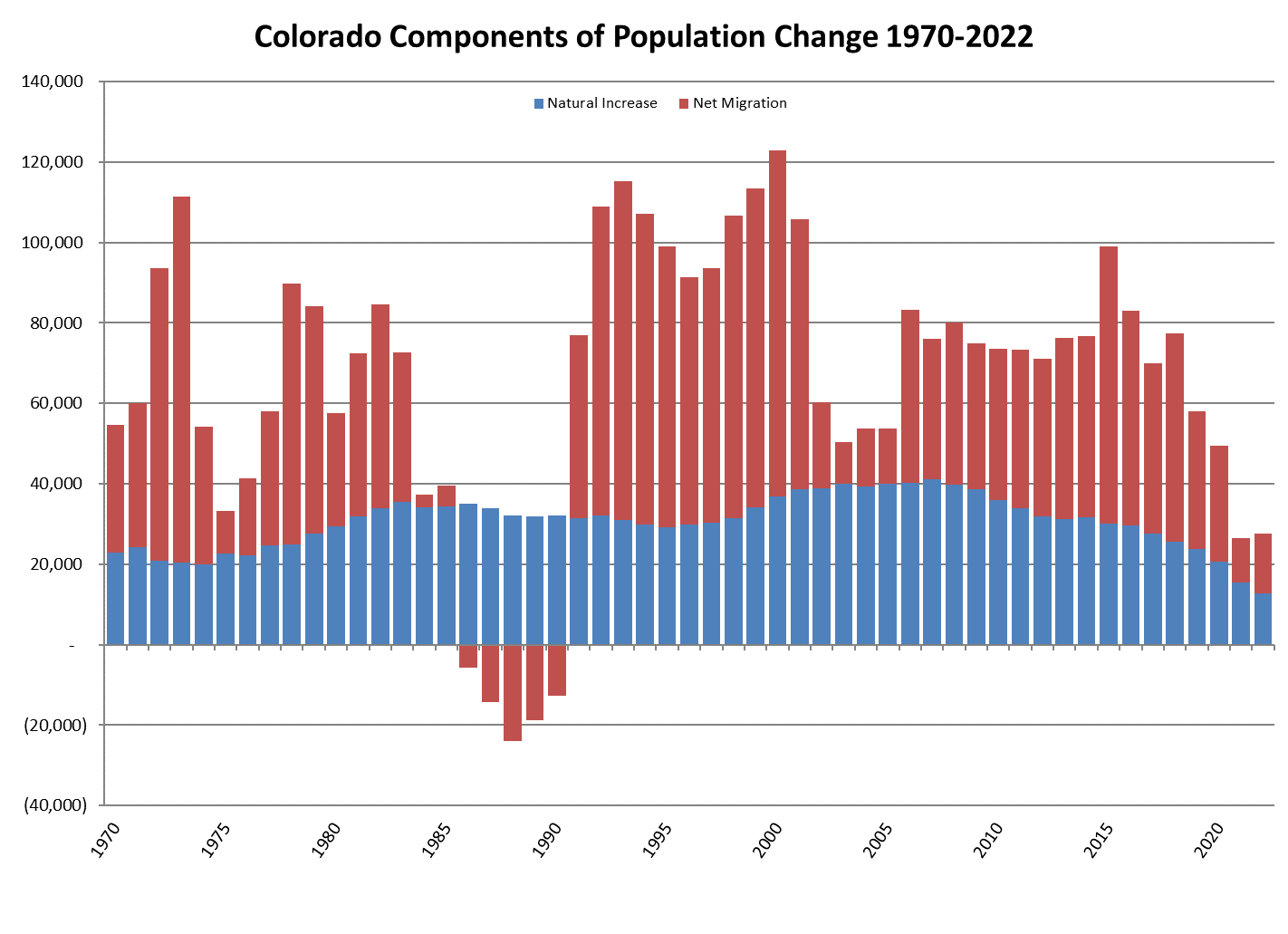
Bar chart showing natural increase which is births minus deaths and net migration combined since 1970. Recently it is showing the slow down in growth from both net migration and natural increase since 2015.
2022 Population Summary February 2024
Colorado's resident population as of July 2022 was 5,838,622, ranking 21st in size in the United States. The state experienced a growth of 27,700, representing a 0.5% increase over Colorado's July 2021 population estimates. Colorado's growth rate from 2021 to 2022 ranked 19th-highest among U.S. states and 12th in total change. This growth is comparable to that of 2021 and notably slower than the annual average of 74,000 and 1.4% during the previous decade, marking the slowest growth rate since the late 1980s.
Colorado's Components of Change
Colorado's total growth in 2022 consisted of 62,500 births and 49,700 deaths, resulting in a natural increase of 12,800 and 15,000 in net migration. Annual births saw an increase of about 500 from the previous year, while annual deaths reached their highest levels on record, attributed to COVID-19 and aging. Sixty-three percent of the 64 counties, or 40 counties, experienced natural decline. The aging population nationwide and in Colorado, coupled with increased mortality due to COVID-19 and fewer births, contributed to the rise in counties experiencing natural decline. Most counties in a phase of natural decline were in non-metro parts of the state, with declines ranging from -900 to -1. However, the metro counties of Pueblo and Mesa led the list of counties in natural decline.
Although births saw a slight increase, they remain lower than the peak of 70,700 in 2007. Births constitute the largest component of population change in Colorado. The slowdown in births will continue to have long-term impacts on K-12 and higher education, as well as the labor force. Each county exhibits unique trends, with most reaching their peak births in 2007, while some, like Jefferson, peaked in 2000. Weld is the sole Front Range County experiencing an increase in births. Early indicators suggest that births will level off and slightly increase in 2023 and 2024 as the number of women in childbearing years rises in the state. Additionally, the largest group of millennials are entering their 30s where birth rates have increased.
Deaths in Colorado have risen, reflecting an increased number of older adults in the state. COVID-19 caused additional increases in deaths in 2020, 2021, and 2022. Between July 2021 and 2022, there were 49,700 deaths, marking an increase of 3,200 from 2021. Natural change (births minus deaths) was 12,800, about 2,700 lower than the previous year. Despite lower levels of natural increase, it ranked as the 7th largest natural increase in the country. Currently, 24 states are in a phase of natural decline with more deaths than births.
Net migration accounted for 14,900 of the state's growth in 2022. International migration was estimated at 10,000, returning to pre-pandemic levels and constituting about 1% of U.S. international migration. The late 2022 arrival of refugees and international migrants will not be reflected in population estimates until 2023 since they occurred after July 1st. Domestic migration was estimated at 4,924, very similar to 2021. Net migration of 14,900 in 2022 was slightly higher than 2021 but significantly lower than the 45,000 annual average during the 2010s. Twenty-six of the sixty-four counties reported net out-migration, with Jefferson, Arapahoe, Denver, Eagle, and Summit counties leading the trend.
| Population Growth 2021-2022 | ||
|---|---|---|
| Rank | County | Population Growth, 2021-2022 |
| 1 | WELD COUNTY | 10,341 |
| 2 | DOUGLAS COUNTY | 6,268 |
| 3 | ADAMS COUNTY | 4,084 |
| 4 | LARIMER COUNTY | 4,068 |
| 5 | EL PASO COUNTY | 3,350 |
| Percentage Growth 2021-2022 | ||
|---|---|---|
| Rank | County | Percentage Growth, 2021-2022 |
| 1 | SAN JUAN COUNTY | 8.1% |
| 2 | CUSTER COUNTY | 5.4% |
| 3 | DOLORES COUNTY | 3.9% |
| 4 | WELD COUNTY | 3.0% |
| 5 | CHAFFEE COUNTY | 2.7% |
| Largest by Population 2022 | ||
|---|---|---|
| Rank | County | Population, 2022 |
| 1 | EL PASO COUNTY | 740,552 |
| 2 | DENVER COUNTY | 712,637 |
| 3 | ARAPAHOE COUNTY | 656,015 |
| 4 | JEFFERSON COUNTY | 575,936 |
| 5 | ADAMS COUNTY | 527,501 |
| 6 | DOUGLAS COUNTY | 376,026 |
| 7 | LARIMER COUNTY | 366,843 |
| 8 | WELD COUNTY | 350,206 |
| 9 | BOULDER COUNTY | 327,424 |
| 10 | PUEBLO COUNTY | 169,383 |
| 11 | MESA COUNTY | 158,534 |
| 12 | BROOMFIELD COUNTY | 76,155 |
Three tables showing 2021-2022 population growth, 2021-2022 percentage growth, and the twelve largest counties in 2022.
Change by County
From 2021 to 2022, forty-seven percent (1,482) of U.S. counties experienced a decline in population. In Colorado, 28 of the 64 counties, or 44%, also saw a decline. Ninety percent of the population growth occurred along the Front Range, with variations observed by county. While Jefferson and Arapahoe declined, there were increases in Douglas, Weld, Adams, and El Paso. The Front Range still accounted for the highest population increase, but many Central Mountains and Western Slope regions experienced faster growth. The tables on the left show the counties with the largest numeric growth between 2021 and 2022, the counties with the largest percent growth between 2021 and 2022, and the twelve largest counties in 2022.
See the full paper here: 2022 Population Summary Report
Please contact the SDO team if you have any questions about the population of Colorado.